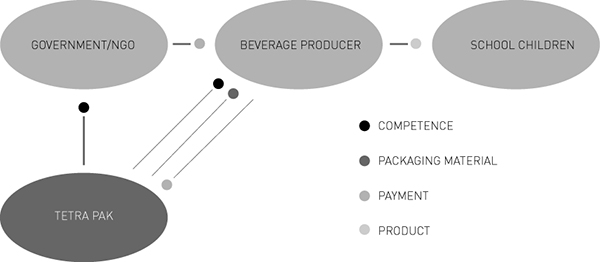In recent years a lot has been said of the strategic virtues of Corporate Social Responsibility (CSR) in terms of its contributions to cost savings and risk management. This connection between CSR and corporate strategy is easy to understand. For example, less wasteful use of resources saves money and the environment, while greater concern for employee welfare can reduce employee turnover costs. On the risk management side, reputation is a key factor where customer misgivings about corporate conduct can lead to reduced revenue streams or even boycotts. This is fairly straightforward. But how can corporations move past such management of costs and risks to actually increasing their revenues with strategic CSR?
Although some commentators do not agree that CSR initiatives need to be profitable “because it’s their moral duty to contribute to societyâ€, all would agree that initiatives that both contribute to profitability and social welfare are desirable. In this context it is worth remembering that corporations have contributed immensely to social welfare since the industrial revolution as innovators, producers, employers, and taxpayers. These social contributions have until recently been performed unintentionally without a concern for CSR, but simply by companies pursuing their core business objectives within the rule of law. The question before us now is how corporations can intentionally contribute further to social welfare while still benefiting themselves. In particular, how can corporations intentionally draw on their core competences in their CSR work in a manner that increases revenues?
Corporate strategy, whether it regards CSR or any other aspect of a business, is always going to be specific to a corporation’s particular circumstances, such as industry, geography, market position etc. There is no one way that will suit all. In this regard there is nothing peculiar about strategic CSR. It is merely corporate strategy, and as such is susceptible to analysis with the standard strategy toolkit taught at most business schools. These include competence analysis, value chain analysis, and PEST-analysis.
Strategic analysis is about understanding the relationship between different forces that affect an organisation’s ability to realise its goal(s). Given a corporation’s goal (often to increase its profit), one needs to understand how its environment consists of obstacles and opportunities as well as how the organisation has resources and competences to overcome obstacles and capitalise on opportunities.
A competence analysis aims at identifying core competences, which are those abilities that a corporation possesses that enable it to perform better than its competition. Such competences should be difficult to imitate otherwise they will not give the organisation a long-term advantage. Often an organisation will not be aware of its core competences because they are part of its everyday activities and are therefore implicit knowledge. A competence analysis is a way of making a corporation aware of the competences within the organisation that create value and market competitiveness.
A competence analysis should start by identifying the different activities that create value in an organisation, which in turn requires a value-chain analysis. Such an analysis divides the organisation into different functions and shows how the value of a product (or service) is developed by the contributions of each corporate function before it finally reaches the customer. In this manner the competence analysis and the value chain analysis become intertwined. Together they show how an organisation creates added value through a sequential process consisting of a number of different competences.
Each function requires a threshold level of competence in order for the enterprise to work as a whole, but, above all, core competences are required within certain functions that distinguish the corporation and make it competitive. Take wholesalers, for example, for them “speed to market†is often a critical success factor. A core competence for these corporations is the logistical ability to effectively distribute their products to their customers.
When corporations are aware of their core competence they can, through an inside-out perspective, identify new opportunities in their external environment. In other words, a corporation’s competence creates added value by solving certain problems, and by identifying new problems that can be solved, new opportunities are created.
A common starting point for analysing a corporation’s external environment is a so called PEST-analysis (Political, Economic, Social and Technological analysis). The idea with this type of analysis is to look at the overarching factors that affect all industries. Corporations are often used to analysing macro-economic and technological circumstances, but have a tendency to miss the forces that are of a political or social nature. To regard CSR from a strategic perspective is largely about paying greater attention to political and social risks and opportunities.
In order to find opportunities for win-win-CSR one may analyse the possibilities for political or social engagement of each function within a corporation given their particular competences. In order to make these abstract analytical notions more concrete, let us now look at the case of Tetra Pak.
Tetra Pak
Tetra Pak is a world leader of packaging and processing of liquid foods. Tetra Pak’s Food for Development Office (FfDO) starts, develops and supports school feeding programmes and agricultural programmes around the world. For more than 40 years Tetra Pak has worked with school feeding programmes now feeding over 43 million school children within the framework of 49 different school feeding programmes. These activities stem from the corporation’s core competences within processing, packaging and distribution of liquid foods.
How does this fit with opportunities to engage in strategic CSR? Through the process of being conscious about its core competences Tetra Pak has been able to analyse its political and social environment in order to find problems that their particular skills are suited to solve. These problems have led to new business opportunities when one has been able to find new methods of financing projects that differ from the traditional model of a customer simply paying for receiving goods and services.
In order to realise school feeding programmes Tetra Pak starts and participates in public-private partnerships. A common scenario is that the corporation offers to provide its competence within school feeding programmes to a government or NGO that has the goal of providing nutritional aid. The most significant difference with strategic CSR in this context, compared with normal business operations, is primarily that some of the recipients of the corporation’s competence are not paying customers. The school children do not pay for the beverages; they are recipients of the governments/NGO’s charity, not Tetra Pak’s. Neither does Tetra Pak receive payment from the government/NGO, but provides practical help without any direct compensation to develop and implement the programmes. Tetra Pak only receives payment when its customers buy packaging material in order to package the beverage for the school feeding programme. The result is that the government/NGO gets access to Tetra Pak’s competence and effective organisation, Tetra Pak gets paid for its packaging material (through its customers), and the school children receive necessary nourishment. This is a win-win-win!
The Stakeholders in Tetra Pak’s Public-Private Partnership

Ulla Holm global director for FfDO says:
“Tetra Pak contributes to public-private partnerships by using its core competences within packaging and dairy production. By cooperating with governments and NGOs and by coordinating the different tasks, FfDO makes sure that the necessary support is available for the different parties to work together towards a common goal.â€
In order to make this more concrete let us look closer at Tetra Pak’s work in Nigeria with the “The Nasarawa State School Feeding Programmeâ€. After having been introduced to Tetra Pak’s “integrated value chain method†in 2005, Nigeria’s President Olusegun Obasanjo took the initiative to help the country’s malnourished children. Tetra Pak has drawn on its previous experience of similar programmes in other countries with similar problems and possibilities. It is interesting to note that a corporation like Tetra Pak initially uses its core competence to capitalise on new opportunities in society, but after many years this leads to the corporation developing a special competence within the new area that can itself be reused over and over again.
The school feeding programme in Nasarawa State distributes Nutri-Sip, which is a beverage that is very rich in protein and contains 30 added vitamins and minerals. What was the result? During the spring of 2007 more than 320 schools in Nasarawa received Nutri-Sip reaching 200 000 children five days per week. What does this mean for Tetra Pak? The corporation receives a good reputation and lays the foundation for a future market for its products while at the same time profiting from the sale of packaging material. The sale of school feeding beverages reached about 40 million packages in 2007. But if Tetra Pak is successful in future negotiations and gets to sell to the majority of future school feeding programmes (to 27 million school children) then the sales could reach 5 billion packages per year, which would be equivalent to 4 percent of Tetra Pak’s global sales simply from one CSR initiative!
Tetra Pak has identified its core competence and has managed to raise its sights to find new opportunities outside its normal business. By offering its competence and suggesting projects to governments and NGOs the corporation has successfully engaged in strategic CSR, which has benefited government/NGOs, malnourished school children around the world, and Tetra Pak itself.
For a corporation to intentionally and strategically contribute to social welfare, beyond cost and risk management, involves an understanding of its competences and how they can solve new problems primarily in its political and social landscape. Devising such opportunities requires concerted analytical effort and creativity, far beyond those of cost saving exercises, but the rewards for both company and community can be much, much greater. This is profitable responsibility!
(David Rönnegard is a senior research fellow at INSEAD. This article is republished courtesy of INSEAD Knowledge http://knowledge.insead.edu. Copyright INSEAD 2012.)
To become a guest contributor with VCCircle, write to shrija@vccircle.com.





